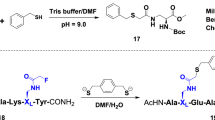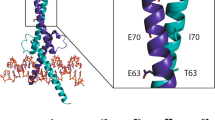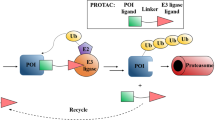Abstract
Specific protein–protein interactions (PPIs) constitute a key underlying mechanism for the presence of a multitude of intracellular signaling pathways, which are essential for the survival of normal and cancer cells. Specific molecular blockers for a crucial PPI would therefore be invaluable tools for an enhanced functional interrogation of the signaling pathway harboring this particular PPI. On the other hand, if a particular PPI is essential for the survival of cancer cells but is absent in or dispensable for the survival of normal cells, its specific molecular blockers could potentially be developed into effective anticancer therapeutics. Due to the flat and extended PPI interface, it would be conceivably difficult for small molecules to achieve an effective blockade, a problem which could be potentially circumvented with peptides or proteins. However, the well-documented proteolytic instability and cellular impermeability of peptides and proteins in general would make their developing into effective intracellular PPI blockers quite a challenge. With the advent of the peptide ‘stapling’ technology which was demonstrated to be able to stabilize the α-helical conformation of a peptide via bridging two neighboring amino-acid side chains with a ‘molecular staple’, a linear parent peptide could be transformed into a stronger PPI blocker with enhanced proteolytic stability and cellular permeability. This review will furnish an account on the peptide ‘stapling’ technology and its exploitation in efforts to achieve an enhanced functional interrogation or manipulation of intracellular signaling pathways especially those that are cancer relevant.
This is a preview of subscription content, access via your institution
Access options
Subscribe to this journal
Receive 50 print issues and online access
$259.00 per year
only $5.18 per issue
Buy this article
- Purchase on Springer Link
- Instant access to full article PDF
Prices may be subject to local taxes which are calculated during checkout






Similar content being viewed by others
Abbreviations
- Aib:
-
2-aminoisobutyric acid
- AKAP:
-
A-kinase anchoring protein
- AKB:
-
A-kinase binding
- BAD:
-
BCL-2-associated agonist of cell death
- Bad −/− :
-
BAD-null
- BAK:
-
BCL-2 antagonist/killer
- BAX:
-
BCL-2-associated X
- BCL-2:
-
B-cell lymphoma 2
- BCL9:
-
B-cell CLL/lymphoma 9
- BCL-W:
-
B-cell lymphoma gene-W
- BCL-XL:
-
B-cell lymphoma-extra large
- BFL-1/A1:
-
BCL-2-related protein A1
- BH3:
-
BCL-2 homology 3
- BID:
-
BH3 interacting domain death agonist
- BIM:
-
BCL-2 interacting mediator of cell death
- EED:
-
embryonic ectoderm development
- eIF4E:
-
eukaryotic initiation factor 4E
- EZH2:
-
enhancer of zeste homolog 2
- GK:
-
glucokinase
- GSIS:
-
glucose-stimulated insulin secretion
- hDM2:
-
human double minute 2
- hDM4:
-
human double minute 4
- hDMX:
-
human double minute X
- HIV-1:
-
human immunodeficiency virus-1
- IRS1:
-
insulin receptor substrate 1
- MAML1:
-
mastermind-like family co-activator protein 1
- MCL-1:
-
myeloid cell leukemia-1
- mDM2:
-
murine double minute 2
- mDM4:
-
murine double minute 4
- mDMX:
-
murine double minute X
- MOM:
-
mitochondrial outer membrane
- NR:
-
nuclear receptor
- PKA:
-
protein kinase A
- PKA-R:
-
protein kinase A—regulatory subunit
- PPI:
-
protein–protein interaction
- PRC2:
-
polycomb repressive complex 2
- RCM:
-
ring closing metathesis
- TCF4:
-
T-cell factor 4.
References
Arkin MR, Wells JA . Small-molecule inhibitors of protein-protein interactions: progressing towards the dream. Nat Rev Drug Discov 2004; 3: 301–317.
Goodman M, Ro S . Peptidomimetics for drug design. In: Wolff ME (ed). Burger’s Medicinal Chemistry and Drug Discovery, 5th edn. John Wiley & Sons, Inc.: New York, NY, USA, 1995, pp 803–861.
McCrudden MT, Singh TR, Migalska K, Donnelly RF . Strategies for enhanced peptide and protein delivery. Ther Deliv 2013; 4: 593–614.
Simerska P, Moyle PM, Toth I . Modern lipid-, carbohydrate-, and peptide-based delivery systems for peptide, vaccine, and gene products. Med Res Rev 2011; 31: 520–547.
Choi YS, David AE . Cell penetrating peptides and the mechanisms for intracellular entry. Curr Pharm Biotechnol 2014; 15: 192–199.
Verdine GL, Walensky LD . The challenge of drugging undruggable targets in cancer: lessons learned from targeting BCL-2 family members. Clin Cancer Res 2007; 13: 7264–7270.
Karle IL . Controls exerted by the Aib residue: helix formation and helix reversal. Biopolymers 2001; 60: 351–365.
Phelan JC, Skelton NJ, Braisted AC, McDowell RS . A general method for constraining short peptides to an α-helical conformation. J Am Chem Soc 1997; 119: 455–460.
Bracken C, Gulyas J, Taylor JW, Baum J . Synthesis and nuclear magnetic resonance structure determination of an α-helical, bicyclic, lactam-bridged hexapeptide. J Am Chem Soc 1994; 116: 6431–6432.
Jackson DY, King DS, Chmielewski J, Singh S, Schultz PG . General approach to the synthesis of short α-helical peptides. J Am Chem Soc 1991; 113: 9391–9392.
Blackwell HE, Grubbs RH . Highly efficient synthesis of covalently cross-linked peptide helices by ring-closing metathesis. Angew Chem Int Ed 1998; 37: 3281–3284.
Schafmeister CE, Po J, Verdine GL . An all-hydrocarbon cross-linking system for enhancing the helicity and metabolic stability of peptides. J Am Chem Soc 2000; 122: 5891–5892.
Verdine GL, Hilinski GJ . Stapled peptides for intracellular drug targets. Methods Enzymol 2012; 503: 3–33.
Bernal F, Katz SG . Synthesis of stabilized α-helical peptides. Methods Mol Biol 2014; 1176: 107–114.
Kaul R, Balaram P . Stereochemical control of peptide folding. Bioorg Med Chem 1999; 7: 105–117.
Kawamoto SA, Coleska A, Ran X, Yi H, Yang C-Y, Wang S . Design of triazole-stapled BCL9 α-helical peptides to target the β-catenin/B-cell CLL/lymphoma 9 (BCL9) protein-protein interaction. J Med Chem 2012; 55: 1137–1146.
Cantel S, Isaad AC, Scrima M, Levy JJ, DiMarchi RD, Rovero P et al. Synthesis and conformational analysis of a cyclic peptide obtained via i to i+4 intramolecular side-chain to side-chain azide-alkyne 1,3-dipolar cycloaddition. J Org Chem 2008; 73: 5663–5674.
Lau YH, de Andrade P, Quah S-T, Rossmann M, Laraia L, Sköld N et al. Functionalised staple linkages for modulating the cellular activity of stapled peptides. Chem Sci 2014; 5: 1804–1809.
Lau YH, de Andrade P, Sköld N, McKenzie GJ, Venkitaraman AR, Verma C et al. Investigating peptide sequence variations for ‘double-click’ stapled p53 peptides. Org Biomol Chem 2014; 12: 4074–4077.
Muppidi A, Zhang H, Curreli F, Li N, Debnath AK, Lin Q . Design of antiviral stapled peptides containing a biphenyl cross-linker. Bioorg Med Chem Lett 2014; 24: 1748–1751.
Muppidi A, Doi K, Edwardraja S, Drake EJ, Gulick AM, Wang HG et al. Rational design of proteolytically stable, cell-permeable peptide-based selective Mcl-1 inhibitors. J Am Chem Soc 2012; 134: 14734–14737.
Muppidi A, Wang Z, Li X, Chen J, Lin Q . Achieving cell penetration with distance-matching cysteine cross-linkers: a facile route to cell-permeable peptide dual inhibitors of Mdm2/Mdmx. Chem Commun (Camb) 2011; 47: 9396–9398.
Haney CM, Loch MT, Horne WS . Promoting peptide α-helix formation with dynamic covalent oxime side-chain cross-links. Chem Commun (Camb) 2011; 47: 10915–10917.
Flint DG, Kumita JR, Smart OS, Woolley GA . Using an azobenzene cross-linker to either increase or decrease peptide helix content upon trans-to-cis photoisomerization. Chem Biol 2002; 9: 391–397.
Madden MM, Muppidi A, Li Z, Li X, Chen J, Lin Q . Synthesis of cell-permeable stapled peptide dual inhibitors of the p53-Mdm2/Mdmx interactions via photoinduced cycloaddition. Bioorg Med Chem Lett 2011; 21: 1472–1475.
Kim YW, Grossmann TN, Verdine GL . Synthesis of all-hydrocarbon stapled α-helical peptides by ring-closing olefin metathesis. Nat Protoc 2011; 6: 761–771.
Urnes P, Doty P . Optical rotation and the conformation of polypeptides and proteins. Adv Protein Chem 1961; 16: 401–544.
Shim SY, Kim Y-W, Verdine GL . A new i, i+3 peptide stapling system for α-helix stabilization. Chem Biol Drug Des 2013; 82: 635–642.
Walensky LD, Bird GH . Hydrocarbon-stapled peptides: principles, practice, and progress. J Med Chem 2014; 57: 6275–6288.
Bird GH, Bernal F, Pitter K, Walensky LD . Synthesis and biophysical characterization of stabilized α-helices of BCL-2 domains. Methods Enzymol 2008; 446: 369–386.
Pitter K, Bernal F, Labelle J, Walensky LD . Dissection of the BCL-2 family signaling network with stabilized α-helices of BCL-2 domains. Methods Enzymol 2008; 446: 387–408.
Edwards AL, Gavathiotis E, LaBelle JL, Braun CR, Opoku-Nsiah KA, Bird GH et al. Multimodal interaction with BCL-2 family proteins underlies the proapoptotic activity of PUMA BH3. Chem Biol 2013; 20: 888–902.
Leshchiner ES, Braun CR, Bird GH, Walensky LD . Direct activation of full-length proapoptotic BAK. Proc Natl Acad Sci USA 2013; 110: E986–E995.
Moldoveanu T, Grace CR, Llambi F, Nourse A, Fitzgerald P, Gehring K et al. BID-induced structural changes in BAK promote apoptosis. Nat Struct Mol Biol 2013; 20: 589–597.
Gavathiotis E, Reyna DE, Davis ML, Bird GH, Walensky LD . BH3-triggered structural reorganization drives the activation of proapoptotic BAX. Mol Cell 2010; 40: 481–492.
Gavathiotis E, Suzuki M, Davis ML, Pitter K, Bird GH, Katz SG et al. BAX activation is initiated at a novel interaction site. Nature 2008; 455: 1076–1081.
Walensky LD, Pitter K, Morash J, Oh KJ, Barbuto S, Fisher J et al. A stapled BID BH3 helix directly binds and activates BAX. Mol Cell 2006; 24: 199–210.
Chen L, Willis SN, Wei A, Smith BJ, Fletcher JI, Hinds MG et al. Differential targeting of prosurvival Bcl-2 proteins by their BH3-only ligands allows complementary apoptotic function. Mol Cell 2005; 17: 393–403.
Danial NN, Walensky LD, Zhang CY, Choi CS, Fisher JK, Molina AJ et al. Dual role of proapoptotic BAD in insulin secretion and beta cell survival. Nat Med 2008; 14: 144–153.
Zha J, Harada H, Yang E, Jockel J, Korsmeyer SJ . Serine phosphorylation of death agonist BAD in response to survival factor results in binding to 14-3-3 not BCL-X(L). Cell 1996; 87: 619–628.
Datta SR, Katsov A, Hu L, Petros A, Fesik SW, Yaffe MB et al. 14-3-3 proteins and survival kinases cooperate to inactivate BAD by BH3 domain phosphorylation. Mol Cell 2000; 6: 41–51.
Thomas S, Quinn BA, Das SK, Dash R, Emdad L, Dasgupta S et al. Targeting the Bcl-2 family for cancer therapy. Expert Opin Ther Targets 2013; 17: 61–75.
Walensky LD, Kung AL, Escher I, Malia TJ, Barbuto S, Wright RD et al. Activation of apoptosis in vivo by a hydrocarbon-stapled BH3 helix. Science 2004; 305: 1466–1470.
Stewart ML, Fire E, Keating AE, Walensky LD . The MCL-1 BH3 helix is an exclusive MCL-1 inhibitor and apoptosis sensitizer. Nat Chem Biol 2010; 6: 595–601.
Beroukhim R, Mermel CH, Porter D, Wei G, Raychaudhuri S, Donovan J et al. The landscape of somatic copy-number alteration across human cancers. Nature 2010; 463: 899–905.
Oltersdorf T, Elmore SW, Shoemaker AR, Armstrong RC, Augeri DJ, Belli BA et al. An inhibitor of Bcl-2 family proteins induces regression of solid tumours. Nature 2005; 435: 677–681.
Tse C, Shoemaker AR, Adickes J, Anderson MG, Chen J, Jin S et al. ABT-263: a potent and orally bioavailable Bcl-2 family inhibitor. Cancer Res 2008; 68: 3421–3428.
LaBelle JL, Katz SG, Bird GH, Gavathiotis E, Stewart ML, Lawrence C et al. A stapled BIM peptide overcomes apoptotic resistance in hematologic cancers. J Clin Invest 2012; 122: 2018–2031.
Tao W, Levine AJ . Nucleocytoplasmic shuttling of oncoprotein Hdm2 is required for Hdm2-mediated degradation of p53. Proc Natl Acad Sci USA 1999; 96: 3077–3080.
Ramos YF, Stad R, Attema J, Peltenburg LT, van der Eb AJ, Jochemsen AG . Aberrant expression of HDMX proteins in tumor cells correlates with wild-type p53. Cancer Res 2001; 61: 1839–1842.
Bernal F, Tyler AF, Korsmeyer SJ, Walensky LD, Verdine GL . Reactivation of the p53 tumor suppressor pathway by a stapled p53 peptide. J Am Chem Soc 2007; 129: 2456–2457.
Bernal F, Wade M, Godes M, Davis TN, Whitehead DG, Kung AL et al. A stapled p53 helix overcomes HDMX-mediated suppression of p53. Cancer Cell 2010; 18: 411–422.
Brown CJ, Quah ST, Jong J, Goh AM, Chiam PC, Khoo KH et al. Stapled peptides with improved potency and specificity that activate p53. ACS Chem Biol 2013; 8: 506–512.
Wei SJ, Joseph T, Chee S, Li L, Yurlova L, Zolghadr K et al. Inhibition of nutlin-resistant HDM2 mutants by stapled peptides. PLoS One 2013; 8: e81068.
Chang YS, Graves B, Guerlavais V, Tovar C, Packman K, To KH et al. Stapled α-helical peptide drug development: a potent dual inhibitor of MDM2 and MDMX for p53-dependent cancer therapy. Proc Natl Acad Sci USA 2013; 110: E3445–E3454.
Bird GH, Crannell WC, Walensky LD . Chemical synthesis of hydrocarbon-stapled peptides for protein interaction research and therapeutic targeting. Curr Protoc Chem Biol 2011; 3: 99–117.
Spiegel J, Cromm PM, Itzen A, Goody RS, Grossmann TN, Waldmann H . Direct targeting of Rab-GTPase–effector interactions. Angew Chem Int Ed 2014; 53: 2498–2503.
Wang Y, Ho TG, Bertinetti D, Neddermann M, Franz E, Mo GCH et al. Isoform-selective disruption of AKAP-localized PKA using hydrocarbon stapled peptides. ACS Chem Biol 2014; 9: 635–642 With a correction to this paper published on: ACS Chem Biol 2014; 9: 1386.
Moellering RE, Cornejo M, Davis TN, Del Bianco C, Aster JC, Blacklow SC et al. Direct inhibition of the NOTCH transcription factor complex. Nature 2009; 462: 182–188.
Takada K, Zhu D, Bird GH, Sukhdeo K, Zhao J-J, Mani M et al. Targeted disruption of the BCL9/β-catenin complex inhibits oncogenic Wnt signaling. Sci Transl Med 2012; 4: 148ra117.
Grossmann TN, Yeh JT, Bowman BR, Chu Q, Moellering RE, Verdine GL . Inhibition of oncogenic Wnt signaling through direct targeting of β-catenin. Proc Natl Acad Sci USA 2012; 109: 17942–17947.
Phillips C, Roberts LR, Schade M, Bazin R, Bent A, Davies NL et al. Design and structure of stapled peptides binding to estrogen receptors. J Am Chem Soc 2011; 133: 9696–9699.
Kim W, Bird GH, Neff T, Guo G, Kerenyi MA, Walensky LD et al. Targeted disruption of the EZH2-EED complex inhibits EZH2-dependent cancer. Nat Chem Biol 2013; 9: 643–650.
Sinclair JK, Denton EV, Schepartz A . Inhibiting epidermal growth factor receptor at a distance. J Am Chem Soc 2014; 136: 11232–11235.
Joseph TL, Lane DP, Verma CS . Stapled BH3 peptides against MCL-1: mechanism and design using atomistic simulations. PLoS One 2012; 7: e43985.
Guo Z, Mohanty U, Noehre J, Sawyer TK, Sherman W, Krilov G . Probing the α-helical structural stability of stapled p53 peptides: molecular dynamics simulations and analysis. Chem Biol Drug Des 2010; 75: 348–359.
Joseph TL, Lane D, Verma CS . Stapled peptides in the p53 pathway: computer simulations reveal novel interactions of the staples with the target protein. Cell Cycle 2010; 9: 4560–4568.
Lama D, Quah ST, Verma CS, Lakshminarayanan R, Beuerman RW, Lane DP et al. Rational optimization of conformational effects induced by hydrocarbon staples in peptides and their binding interfaces. Sci Rep 2013; 3: 3451.
Frank AO, Vangamudi B, Feldkamp MD, Souza-Fagundes EM, Luzwick JW, Cortez D et al. Discovery of a potent stapled helix peptide that binds to the 70N domain of replication protein A. J Med Chem 2014; 57: 2455–2461.
Hao Y, Wang C, Cao B, Hirsch BM, Song J, Markowitz SD et al. Gain of interaction with IRS1 by p110α-helical domain mutants is crucial for their oncogenic functions. Cancer Cell 2013; 23: 583–593.
Gembarska A, Luciani F, Fedele C, Russell EA, Dewaele M, Villar S et al. MDM4 is a key therapeutic target in cutaneous melanoma. Nat Med 2012; 18: 1239–1247.
Chin L . The genetics of malignant melanoma: lessons from mouse and man. Nat Rev Cancer 2003; 3: 559–570.
Bird GH, Gavathiotis E, LaBelle JL, Katz SG, Walensky LD . Distinct BimBH3 (BimSAHB) stapled peptides for structural and cellular studies. ACS Chem Biol 2014; 9: 831–837.
Acknowledgements
WZ is a Jiangsu provincial specially appointed professor and a recipient of the Jiangsu provincial ‘innovation and venture talents’ award plan, and the associated financial supports to the completion of this manuscript are appreciated.
Author information
Authors and Affiliations
Corresponding author
Ethics declarations
Competing interests
The authors declare no conflict of interest.
Rights and permissions
About this article
Cite this article
He, Y., Chen, D. & Zheng, W. An enhanced functional interrogation/manipulation of intracellular signaling pathways with the peptide ‘stapling’ technology. Oncogene 34, 5685–5698 (2015). https://doi.org/10.1038/onc.2015.37
Received:
Revised:
Accepted:
Published:
Issue Date:
DOI: https://doi.org/10.1038/onc.2015.37
This article is cited by
-
Protein modification in a trice
Nature (2015)



